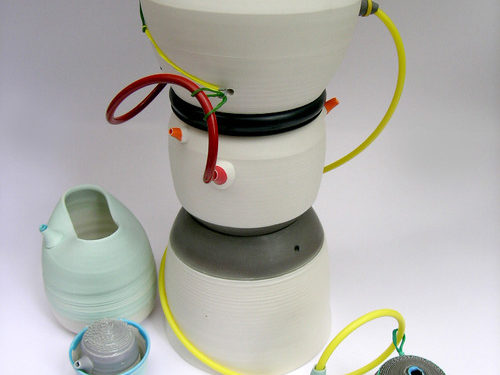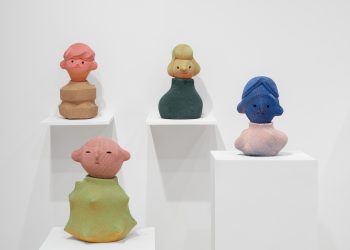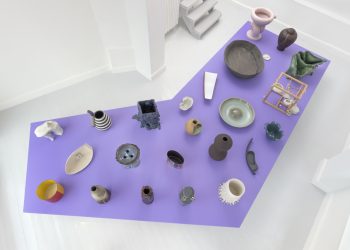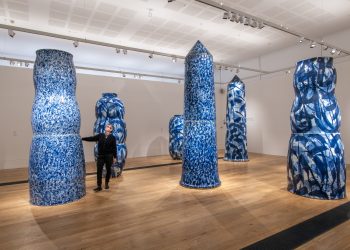CLASS OF 2013 / The National Centre for Craft and Design, Sleaford, UK
November 22, 2013 – January 19, 2014
Each year,The National Centre for Craft and Design in Sleaford, Lincolnshire, UK selects work by the very best of the current year’s graduates from art colleges and universities all over the UK, and gives them the opportunity of exhibitingat the NCCD.
This year’s show explores the theme of function in objects. A range of high quality, visually striking artworks created by 18 specially selected graduates are on display. They demonstrate a diverse range of skills from fashion and jewellery to ceramics and automata.
Class of 2013 will be open to the public until Sunday 19 January 2014 everyday excluding Christmas Day, Boxing Day and New Years Day from 10am to 5pm (3pm Christmas Eve).
Ceramicists exhibiting in Class of 2013:

Luke Bishop, Rongorongo: Forgotten Function 5, 2013, Porcelain and stoneware with latex additions, maximum H46 cm. Photo by Scott Murray.
Luke Bishop
HE Diploma in Fine and Applied Arts in Ceramics
CityLit / London Metropolitan University
Rongorongo; Forgotten Function is an exploration rooted in the language of function where both memory and meaning are lost. False lids, multiple spouts (some obstructed, some fixed, others detachable), curiously and illogically-placed holes and tubes intentionally disturb the recognized and accepted grammar and syntax of function, causing the viewer and potential user to experience a disruption in the affordance towards the object.
In much the same way that an object excavated from the archaeological record only reveals to us a portion of its story, the meaning and uses of these vessels can never be completely recovered and known. Because the link between craft and everyday use has been permitted to slowly slip away from our collective experience, we are left with what we can only interpret but never fully explain. Function is forgotten.
Luke’s work seeks to invite the viewer to wonder at these curious vessels, and to provoke us to awaken to the process of cultural richness being lost. Its creative corollary, however, is that such richness can endure when care is taken to preserve meaning, ritual, skill and knowledge?

Zoe Clare, Invading Forms #4, #5, #6, #7, 2013, Porcelain, 56×61 / 34×48 / 17×30 / 30×60 cm. Photo by Scott Murray.
Zoe Clare
BA (Hons) Ceramic Design
Central Saint Martins – University of Arts London
Zoe is an artist who works predominantly with ceramic. She creates sculptures that are visually absorbing, rich in layers, texture and integral repetitive patterns.
Zoe is influenced by the natural world around her and the discoveries made during her travels. The natural world, often overlooked, provides her with rich visual resources, which she then interprets and uses as a vessel to convey commentary and observations.
The ‘Invading Forms’ series explores the effects and conservational issues of invasive, non-native plants and their effects on the bio diversity of South Africa’s endangered environment. The sculptures are a metaphor for the conservational issues and endangered biodiversity we are facing today.
The sculptures, created in porcelain, take on the aggressive character of the invasive plants and become an invading form, growing organically and intrusively, absorbing anything and everything that is in its path.
These structural forms are concerned with internal and external spaces and holds remnants of the extinct plants it has devoured inside for spectators to see. Sections of the invading forms are open, allowing the insides to be examined. Within are surprising textures and glazes depicting the exotic nature of the diminishing South African fauna and flora.

Jade Crompton, Bubble vases, Ceramics, slip cast, semi porcelain, Pieces between 23×24 cm. Photo by John James Clare.
Jade Crompton
BA (Hons) Design
Liverpool Hope University
Combining traditional plaster mould making techniques with the modern techniques of 3D design, Jade uses prototypes and digital model making to create unique moulds for slip casting.
Jade enjoys taking natural forms and applying structure and pattern using digital software, giving an organic and manmade appearance to her work. Overall her work is intended to be both aesthetically pleasing and functional.
Her current work focuses on casting plaster moulds from 3D printed models and layering laser cut pieces of perspex, this process allows Jade to produce more detailed and precise designs. The works are inspired by the layers found in natural formations such as lava, rock and ice.
Instead of using glazes or coloured slips which Jade finds too unpredictable, she uses airbrushed layers of under glaze which leaves a even matte coverage. She also adds a layer of clear glaze to the inside of her pieces which renders them waterproof.

Ruth Harrison (Porcelain, 2013, Photos by Scott Murray)
Green Gradiant Strip / Red Gradiant Strip, 200×95 mm.
Blue Disk with Orange Inlay / Yellow Disk with Blue Inlay / Green Disk with Red Inlay, 130×95 mm.
Ruth Harrison
BA (Hons) Ceramics
Plymouth College of Arts
Ruth Harrison uses porcelain to create sculptural forms using repeated elements. She is interested in symmetry and the idea of taking one shape and multiplying it many times over or around a cylinder. Her work evokes the childhood memory of running a hand or stick along a fence.
Ruth chooses to use porcelain due to its white body when fired to 1260°c. Porcelain also works very well with coloured stain which she uses for some of her collections.
Ruth draws the attention of the viewer to a section or strip of the finished piece using colour, texture or pattern which is added to the piece as it is being made. Each disk is hand cut using a cookie cutter from 3mm thick slabs of porcelain which are then cut in half, sponged, scored, slipped and attached to a slip-cast cylinder.

David Marques (2013, Photos by Scott Murray, All four pieces 290×400 mm.)
Ornaments / Reflections, Hand painted porcelain and figurines
Tweet Me! 2013, Porcelain with transfers and wine
Depression, 2013, Porcelain with transfers and hand painted
David Marques
BA (Hons) Ceramic Design
Central Saint Martins – University of the Arts, London
David says when he tells people he grew up in Switzerland most people think of ‘secret bank accounts’, ‘clocks’ and ‘precision’.
“In Italy for 30 years under the Borgias they had warfare, terror, murder, and bloodshed, but they produced Michelangelo, Leonardo da Vinci, and the Renaissance. In Switzerland they had brotherly love – they had 500 years of democracy and peace, and what did that produce? The cuckoo clock.”(Orson Wells, The Third Man, 1949)
The Memento Collection is David’s response to this prejudice, re-interpreting the cuckoo clock using Welles’ renaissance quote as a stepping stone. The project explores time, not as a keeper of time for a busy schedule, but as a reminder of the preciousness of the moment. A moment to put the world on pause and remember our dreams.
David has created six versions with different personal responses to things around him, including: the economic crisis in Portugal, social networking, death and his childhood. Each clock represents a different story that mixes the Swiss fascination with clocks with the Portuguese reality. The project was made in collaboration with the Portuguese porcelain manufacturer Vista Alegre.

Charlotte Mary Pack, Fading Away (detail), Paper Porcelain, approx. 150×50 cm. Photo by Scott Murray.
Charlotte Mary Pack
BA (Hons) Ceramic Design
Central Saint Martins – University of Arts London
Growing up on a Farm inspired Charlotte’s early passion and love for nature, and in particular animals. Living in the countryside constantly surrounded by wildlife, and a recent trip to Africa are key experiences which inspire and drive her work.
Charlotte’s work lays emphasis on the exploration of the relationship between man and animal. Life on earth is under serious threat due to the destructive behaviour of mankind. Charlotte wishes to highlight this issue through hand building animals in clay with a vital interest in capturing energy and soul.
This collection represents the 196 critically endangered mammals on the IUCN ‘Redlist’ (International Union for the Conservation of Nature). Charlotte hand built every mammal on the list in paper porcelain, with a vital interest in capturing each animal’s character, and then high fired them. Presenting them as though they are ‘fading away’ into extinction reflects their position in wild.

Joshua Schot, Crafty Bowl 01, 2013, Ceramic, 200×420 mm. Photo by Scott Murray.
Joshua Schot
MA Ceramics and Glass
Royal College of Art, London
Joshua’s work aims to explore a direct comparison between art and craft by purposely colliding the two opposing sets of values. To think there was once a time when the distinction between art and craft did not exist, as all things were crafted, is to think of a time of simpler values. Joshua explores these values by subverting preconceived ideas that a piece of work can subscribe to particular traits and be considered conceptual art.
Joshua has effectively spoilt the bowls by capping them; through consciously taking away the functionality he leaves the viewer feeling unfulfilled, asking for a bowl to be presented in its traditional form.
The success of his work is through its resonance, there is of course the moment of understanding when viewing the pieces that Joshua seeks; though ultimately he hopes for the viewer to walk past ostentatious art to seek the crafted object.
CONTACT
info@nationalcraftanddesign.org.uk
Tel. 01529 308710
The National Centre for Craft & Design
Navigation Wharf
Carre Street
Sleaford, Lincolnshire NG34 7TW
United Kingdom
www.nationalcraftanddesign.org.uk
> More exhibitions / View the list of ceramic art exhibitions worldwide



















